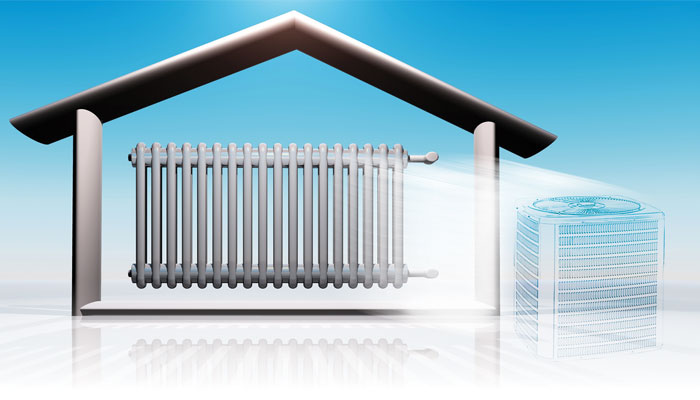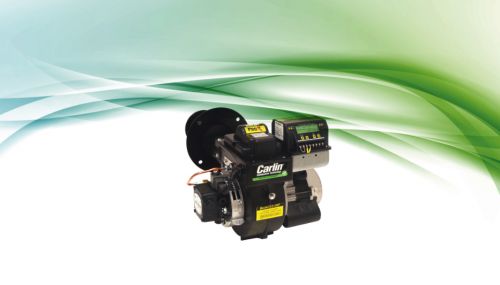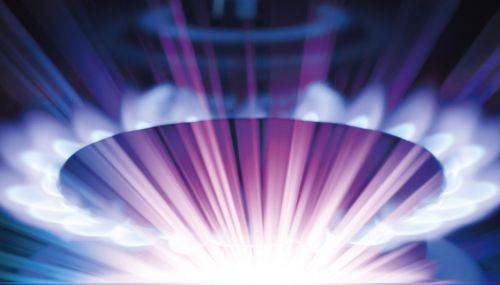All
Choose the Right Heat Pump
by Shawna Henderson, Blue House Energy

Bivalent heat pumps offer advantages in retrofits
By Shawna Henderson, Blue House Energy
An air-to-air system is what North Americans typically think of when they hear the term “heat pump.” That is because the predominance of central air conditioning and forced-air heating systems use air-to-air as the distribution medium in the mature heat pump markets of North America.
Water distribution systems (hydronic systems) are predominantly used in Europe, Canada and the northeastern part of the United States, coinciding with areas where oil- or gas-fired boilers feeding radiators is a common choice of heating system.
The retrofit market in North America falls back on two types of all-electric heat pumps to replace existing oil or gas fired heating systems: central ducted units for houses with central ducting in place or ductless ‘mini-split’ systems for houses that rely on other distribution methods such as radiators or strip electric.
Air-to-air systems extract energy from outside air and transfer the heat to either the inside of the house or the outside, depending on the season. Other types of heat pumps extract energy from water and move it to water or air, and still others extract energy from air and transfer it to water.
Air-to-air heat pumps are typically all-electric systems, although a Canadian contribution to heat pump technology is the bivalent heat pump. “Bivalent” is a term from biology that relates to pairs. Bivalent heat pumps use a fuel-fired burner to boost the temperature of the air entering the outdoor coil. This allows these units to operate at lower outdoor temperatures. In this dual mode system, the heat pump is typically paired with a conventional boiler, with the heat pump acting as the lead heating source and the boiler taking the lead when the demand exceeds the supply from the heat pump in periods of low temperature.
Ideal for Retrofits
Add-on, or hybrid, heat pump systems—the retrofit solution to a purpose-built bivalent heat pump—are employed in situations where the existing system is in good condition, but there is need to improve the efficiency of the heating system, or drop the reliance on fossil fuel consumption, or both. These add-on heat pumps are being used in the United Kingdom and other European markets to supplement existing gas or oil-fired boiler systems with hydronic distribution, although they are still very much a niche product.
What we in North America are most familiar with—a heat pump with an auxiliary electric resistance heat source that is designed to meet the maximum heat load—can be called a ‘monovalent’ heat pump. Heat pumps work at lower water temperatures than existing oil or gas boilers. This makes it tricky to retrofit an existing hydronic distribution system with a monovalent heat pump, as the existing radiators may not be large enough to provide adequate heat at design temperature conditions. Changing out radiators creates more disruption than most property owners are prepared to accept, unless they are carrying out a large-scale retrofit or addition.
With a bivalent or hybrid system, the heat pump works in synergy with the existing boiler, leaving the distribution system intact. When designing a hybrid system, the heat pump is sized for 20 percent to 60 percent of the maximum heat load, and the existing gas or oil boiler meets the peak load. Connecting the boiler in parallel to the heat pump allows for a lower capacity heat pump, reducing the investment cost, and covering the heating load during the milder shoulder seasons, when the Coefficient of Performance (COP) of the heat pump is at its highest.
The COP of a water-to-water heat pump varies with the distribution/return temperature. The difference looks like this:
Conventional radiators (60-90°C): COP 2.5
Modern radiators (45-55°C): COP 3.5
Floor heating (30-45°C): COP 4
Because it is installed to cover only a part of the heating season, the heat pump in a bivalent or hybrid system is sized to 40 to 60 percent of the heating capacity at the heating design temperature. As the outdoor design temperature occurs for less than 1 percent of the heating season, and the typical outdoor temperature throughout the heating season is much higher, the heat pump can provide the lion’s share of the annual heat load. In fact, in the UK, regulations for this type of system require that the system be sized so that the non-renewable, supplementary heating source supplies less than 5 percent of annual energy requirement. (To geek out further on the technical aspects, check out the BS EN15450:2007 standard, which covers the design of heat pump heating Systems).
Matching the Components
A heat pump operates most effectively when the temperature difference between the heat source and heat sink (distribution system) is small, so the heat distribution temperature for space heating heat pumps should be kept as low as possible during the heating season.
Where radiators are concerned, higher operating temperatures can reduce the effectiveness of the heat pump. When serving a high-temperature distribution system originally supplied by a boiler, a heat pump provides supply temperatures that will be only half that from the boiler. However, many older radiator systems are oversized, helping to balance out the drop in supply temperature, especially in the shoulder seasons.
For renovation and addition projects, where new and old distribution systems could be combined, a bivalent or hybrid system can supply both radiators and in-floor heating, with the supply water temperature set at a level suitable for the radiators. A mixing circuit or stepdown valve would need to be added to the system design to reduce the water temperature in the floor heating loops.
In-floor, low-temperature hydronic heating (or a fan coil) is the best choice for retrofit projects that include changing out the distribution system, because of the compatible temperature match between supply and demand.
Designing the controls for the system is important to optimize the energy savings. There are two ways of controlling bivalent systems, and this is where a careful analysis of the building envelope and existing heating system performance is key to improving comfort level and decreasing energy consumption. The first is where the system chooses which heat source to used based on which is the most cost effective. The second is where the system switches from heat pump at low ambient temperatures.
Cost-effective control: A flow temperature of X degrees is required. The heat pump supplies this flow temperature until the ambient temperature drops below the level where the heat pump is cost effective. At this point, the system switches to the boiler. The distribution points (radiators or in-floor loops) must match the flow temperature, and the heat pump has to be sized to the heating demand at the cut-off point.
Ambient temperature control: A flow temperature of X degrees is required. When the ambient temperature goes down far enough, and a flow temperature higher than X degrees is required to maintain comfort levels, the system switches to the boiler to increase the flow temperature. This works when the distribution points (radiators or in-floor loops) are too small to provide enough heat at flow temperature X and lower ambient temperatures.
Bivalent systems can also produce hot water for domestic use. Advancements in heat pump technology (particularly systems that use carbon dioxide as the refrigerant) have led to systems that can successfully provide domestic hot water at 60°C
Related Posts
 Burner Questions? The Answer Is in Your Hands.
Burner Questions? The Answer Is in Your Hands.
Posted on April 17, 2024
 Carlin Begins Production on UL Listed B100 Burners
Carlin Begins Production on UL Listed B100 Burners
Posted on December 7, 2023
 NORA Looks at Indoor Air Quality
NORA Looks at Indoor Air Quality
Posted on December 7, 2023
 Why Market Renewable Propane for Your Business?
Why Market Renewable Propane for Your Business?
Posted on October 6, 2023
Enter your email to receive important news and article updates.
